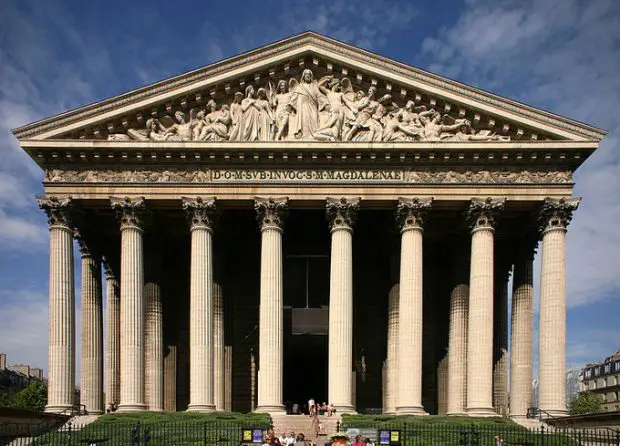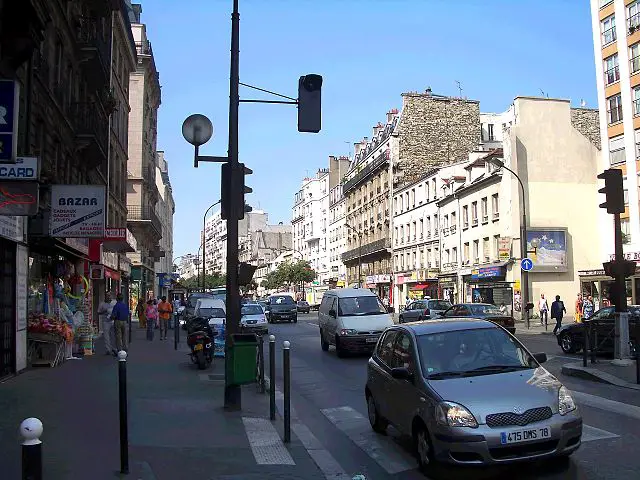In recent years, thanks to its central location and vibrant mix of activities, Châtelet-Les Halles has become one of the most popular neighborhoods in Paris. Here are some ideas for things to do and places to explore in the area.
But first, let’s pinpoint our locations on a map:
Want a version of this map you can print or save on your phone?
I’ve created a pack with 13 one-page neighborhood maps—including this one. Each map comes with a quick guide and a QR code that links back to the full guide and the custom Google Map. Perfect for trip planning or exploring on the go.
Place du Châtelet
Voir cette publication sur Instagram
This iconic, tree-lined square is a lively meeting point in the heart of Paris.
Every day, countless pedestrians pass through, crossing paths near the beautiful Palm Tree Fountain at its center, watched over by the four sphinxes carved into its basin.
The real showstopper, however, is the fountain’s towering column, rising 22 meters into the sky, crowned by a proud angel at the top.
What I love:
- The stunning Palm Tree Fountain and its impressive column.
- The shaded, peaceful atmosphere of the square.
Westfield Forum des Halles
101 Porte Berger, 75001 Paris
Voir cette publication sur Instagram
Westfield Forum des Halles is one of the most iconic shopping malls in Paris, home to over 150 stores offering something for everyone.
More than just a shopping center, it’s a vibrant hub featuring cinemas, dining spots, and terraces, making it a great place for entertainment and relaxation.
What I love:
- The impressive glass canopy that floats above the mall.
- The Multiplex cinema for a fun movie night.
Nelson Mandela Garden
All. Jules Supervielle, 75001 Paris
Voir cette publication sur Instagram
The Nelson Mandela Garden is a peaceful green oasis located right above Forum des Halles.
Its wide lawns offer a refreshing escape, bringing a touch of nature to the busy urban neighborhood.
The garden is also kid-friendly, with plenty of playgrounds and fun activities for children. There are even ping-pong tables for a bit of friendly competition!
What I love:
- The charming music pavilion.
- The popular adventure playground that kids adore.
Châtelet Theater
2 Rue Edouard Colonne, 75001 Paris
Voir cette publication sur Instagram
This prestigious theater is renowned for its remarkable architecture and eclectic programming, ranging from opera to dance or musical theater.
With its refined premises, the Châtelet Theater offers a unique cultural experience. A once-in-a-lifetime opportunity not to be missed!
What I love:
- The excellent programming
- The splendid gilded façade of the theater adds to its mystique
Pompidou Center
Place Georges-Pompidou, 75004 Paris
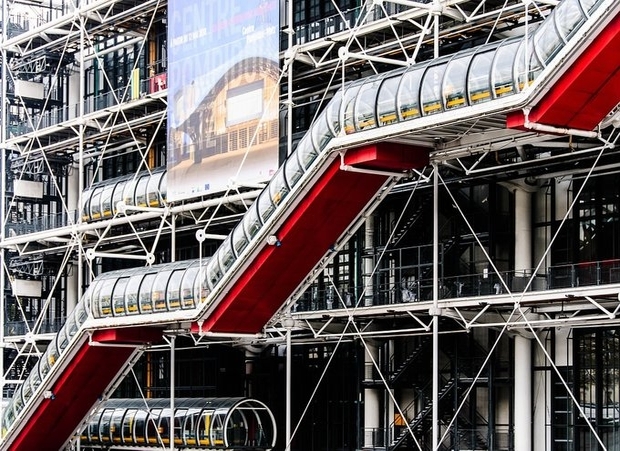
With its innovative and modern design, the Pompidou Center stands out. You can hardly miss the web of multicolored pipes making up its façade.
Home to the National Museum of Modern Art, the center contains an extensive collection of 20th-century artwork.
If you plan to visit the place for the first time, all the necessary information is in this guide.
What I love:
- The stunning view over Paris from the gigantic escalator
- The vast collection of more than 7,000 works
Stravinsky Fountain
Place Igor Stravinsky, 75004 Paris
Voir cette publication sur Instagram
The Stravinsky Fountain, next to the Centre Pompidou, is one of the most colorful and playful fountains in Paris.
Created in 1983 by artists Jean Tinguely and Niki de Saint Phalle, it features 16 moving sculptures that spray water, each inspired by the music of composer Igor Stravinsky.
The sculptures are bright, quirky, and fun to watch, with shapes like hearts, lips, and musical instruments.
What I love:
- The fun, colorful sculptures that bring the square to life.
- Its location right next to the Pompidou Center.
Saint-Jacques Tower
Square de la Tour Saint-Jacques, 75004 Paris
Voir cette publication sur Instagram
Nestled at the feet of the gothic marvel that is Saint-Jacques Tower, this beautiful square dotted with benches and shaded spots is the perfect place to be in case of high temperatures.
A true urban oasis!
The icing on the cake: from mid-May to mid-November, visitors can enjoy an exceptional view of the neighborhood from the top of the tower.
What I love:
- The picturesque Saint-Jacques Tower with its 54 meters high.
- The pretty and perfectly maintained flower beds
Rue Montorgueil
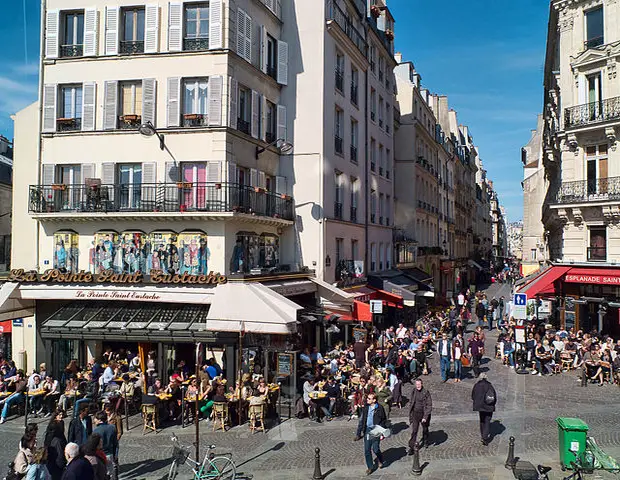
Rue Montorgueil is one of Châtelet’s most famous and lively streets.
This pedestrian street comes alive every morning to the sound of bustling cafés, bakeries, bars, and restaurants. In short, things never slow down here!
Montorgueil is also a market street full of thrift stores and clothes retailers, making it an unmissable stop for fashionistas in the neighborhood.
What I love:
- The provincial charm of the cobblestone streets
- The always welcoming atmosphere
L’Escargot Montorgueil
38 Rue Montorgueil, 75002 Paris
Voir cette publication sur Instagram
Founded in 1832, this iconic restaurant is famous for its traditional French dish: escargots (snails).
The beautiful Art Nouveau décor and golden snail sculptures make it a special spot for a classic Parisian experience.
What I love:
- Trying escargots, a must-try French dish!
- The beautiful, historic interiors.
E. Dehillerin
18 Rue Coquillière, 75001 Paris
Voir cette publication sur Instagram
A dream shop for cooking enthusiasts! Open since 1820, E. Dehillerin is where chefs and food lovers buy professional kitchen tools.
You’ll find everything from copper pans to sharp knives and pastry molds.
What I love:
- Exploring the shelves filled with high-quality tools.
- Feeling like a professional chef in this historic shop.
Stohrer
51 Rue Montorgueil, 75002 Paris
Voir cette publication sur Instagram
Founded in 1730, Stohrer is the oldest pastry shop in Paris.
It’s famous for its baba au rhum (rum cake), éclairs, and beautiful cakes.
The ornate interior and delicious pastries make it unforgettable.
What I love:
- Tasting the original baba au rhum.
- The shop’s beautiful, historic décor.
Au Pied de Cochon
6 Rue Coquillière, 75001 Paris
Voir cette publication sur Instagram
This legendary brasserie has been open 24/7 since 1947!
It’s famous for its hearty French dishes like French onion soup and crispy pork specialties.
It’s a great place for a late-night Parisian meal.
What I love:
- Dining anytime, day or night.
- The authentic French dishes in a lively setting.
Rue des Lombards
Voir cette publication sur Instagram
A lively street in the Châtelet area known for its jazz clubs and nightlife.
Famous spots like Sunset-Sunside and Le Duc des Lombards host live music performances, perfect for an evening out.
What I love:
- Listening to live jazz in cozy clubs.
- Enjoying the vibrant energy of the street.
Passage du Grand-Cerf
145 Rue Saint-Denis, 75002 Paris
Voir cette publication sur Instagram
Welcome to the “Passage du Grand Cerf.” With its ten-meter-high ceiling and stately 19th-century architecture, it is one of the most picturesque shopping arcades in the capital.
It is a welcoming place, best known for its charming stores, ranging from high-end fashion boutiques to interior design and artisanal crafts outlets.
What I love:
- The immense glass ceiling and the flood of light that pours from it.
- Le Pas Sage: The restaurant cleverly tucked in the passage.
Bourse du Commerce – Collection Pinault Museum
2 Rue de Viarmes, 75001 Paris
Voir cette publication sur Instagram
The old building of the Bourse du Commerce has become an emblematic part of the neighborhood since its transformation into a cultural exhibition center.
Around 10,000 artworks from the Pinault Collection are displayed there, with many other modern art pieces.
The place is also renowned for its beautiful architecture, notably the glass dome capping the building.
What I love:
- The splendor of the place
- The extensive art collection
Saint-Eustache Church
2 Imp. Saint-Eustache, 75001 Paris
Voir cette publication sur Instagram
This gothic church is an architectural marvel that distinguishes itself with its arresting façade and sumptuous halls.
Inside, visitors flock to admire the superb stained-glass windows. They also enjoy the excellent acoustics, so valuable for the various concerts and musical events regularly hosted there.
In short, Saint-Eustache Church is a one-of-a-kind cultural landmark sure to delight visitors.
What I love:
- The imposing organ overlooking the interior hall
- The regular choral and philharmonic concerts hosted here
Le Petit Bouillon Pharamond
24 Rue de la Grande Truanderie, 75001 Paris
Voir cette publication sur Instagram
This classic French Bistro in the center of Les Halles is very popular with the locals.
What is a “bouillon”? It’s pretty simple: a budget-friendly restaurant serving traditional dishes.
So, you know where to go if you want to eat a genuine Burgundy beef stew for €10,50 or a € 4,50 “tarte tatin” (a caramelized apple pie cooked upside down).
The old-school design also gives it quite a unique atmosphere.
What I love:
- The affordable prices
- The variety of dishes offered.
Rue Saint-Denis
Voir cette publication sur Instagram
When passers-by enter this long pedestrian street steeped in history near Chatelet, they follow the path France’s kings took during ceremonial events.
Perfect for leisure strolls, this narrow street (which widens near Place du Châtelet) is also a hub of activities.
Everything can be found here, from dining spots, cafés, clubs, and theaters to tattoo parlors and sex shops.
What I love:
- The impressive arch of Porte-Saint Denis at the end of the street.
- The unique atmosphere and the cosmopolitan side of this street.
Les Bouquinistes
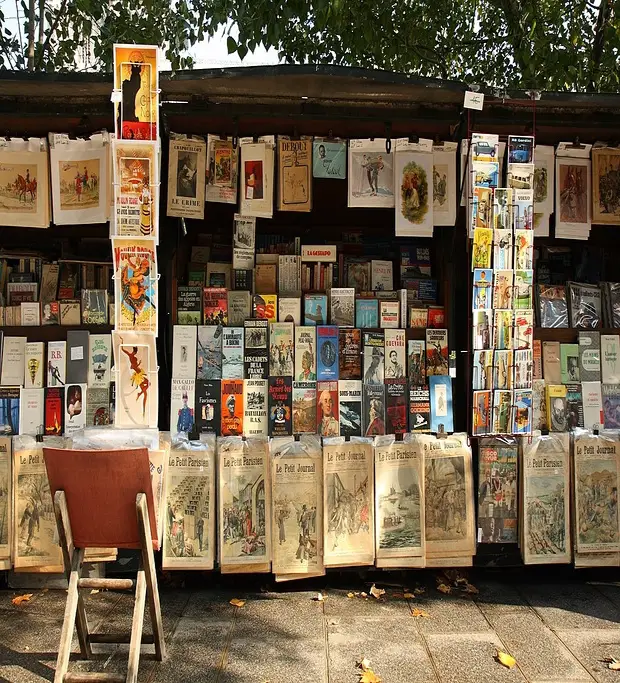
There is plenty to discover in this vast open-air bookstore.
Hundreds of stalls filled with books stretch along more than 3 km on both sides of the Seine.
This treasure trove of books has more than 300,000 second-hand volumes.
What I love:
- The wide selection of books and magazines
- The quirky atmosphere
Saint-Merry Church
76 Rue de la Verrerie, 75004 Paris
Voir cette publication sur Instagram
If there’s one thing to see in the neighborhood, it’s Saint-Merri Church’s façade and the playful gargoyles hanging from it.
This charming church hosts unique and compelling concerts and exhibitions all year long. Give it a try!
What I love:
- The Church’s weekly piano and flute recitals.
- The unique atmosphere
59 Rivoli
59 Rue de Rivoli, 75001 Paris
View this post on Instagram
A stone’s throw from Place du Châtelet, this versatile cultural center is an all-in-one creative space serving as a workshop, an art gallery, and a concert hall.
It is a true temple of street art characterized by a vibrant urban style drawing from many sources of inspiration.
What I love:
- The free admission
- The workshop’s many colored rooms, perfect for taking some pictures.
La Samaritaine
9 R. de la Monnaie, 75001 Paris
Voir cette publication sur Instagram
A five-minute walk from Place du Châtelet, this department store is a must-see destination, if only for the Art-Nouveau design of the building’s façade.
With its fashion boutiques and perfumeries, this iconic venue embodies Parisian luxury.
It is also a perfect stopover to discover a part of the capital’s history.
What I love:
- The impressive glass roof overlooking the stores
- The open-access photo studio. Ideal for a keepsake.
Restaurant Dans le Noir
51 R. Quincampoix, 75004 Paris
Voir cette publication sur Instagram
How about treating yourself to a gourmet meal in total darkness?
That’s precisely what the restaurant Dans le Noir offers, just a five-minute walk from the Châtelet – Les Halles metro exit.
Are you ready to eat without relying on your sight but on your other senses for the duration of a meal?
This unique dinner has everything to ensure you have an unforgettable evening.
What I love:
- The unique experience of being plunged into the dark.
- The very attentive service from the blind or partially sighted servers.
Le Louchebem
10 Rue des Prouvaires, 75001 Paris
Voir cette publication sur Instagram
Attention meat lovers: this historical brasserie near Châtelet – Les Halles was made for you.
Indulge in an all-you-can-eat roaster’s plate with hip beef, lamb leg, and roasted ham.
What I love:
- The delicious vegetable side dish
- The wide variety of meats

With a passion for travel and having visited over 50 countries, Dorian is eager to share his favorite spots and expert tips to help you explore Paris and France like a local.

